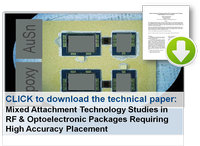Do you happen to know someone who does not own some type of wireless device? It is becoming rarer today to meet someone who does not. Fueling the growth of the RF and microwave industries today is the demand for these connected devices. Let’s explore these devices at the packaging level—what are the challenges and best practices?
RF/Microwave and Semiconductor Packaging
The RF and microwave markets are characterized by lower volume and higher mix when compared to semiconductor packaging. This requires different levels of manual and automatic assembly process steps depending on product and manufacturing maturity. Suppliers can help customers through the various stages of manufacturing automation by providing manual, semi-automatic and fully automatic islands and lines of equipment and process.

Eutectic and Adhesive Attachment
The increasingly densely populated and higher power levels of RF packages are creating unique challenges for assembly process engineers. Both eutectic and adhesive attachment processes are faced with smaller component sizes, more closely spaced components, and a need for lower voiding content. As a result, solder or epoxy outflow may affect the position and attachment quality of adjacent components, or it can contaminate the top surface of these components. Die attach equipment must be capable of handling these demanding requirements without compromise to quality or cycle time.
RF packages continue to shrink in size with less space for die. Power densities are
increasing as well. Packaging engineers are exploring a switch from conductive adhesive to eutectic solder attachments on high power components. Lower power components still allow adhesive attachment but have their own challenges due to tight spacing.
Adhesive attach is common in a large variety of packaging applications and relatively well supported in the industry. Adhesive is typically applied by means of screen printing, pin transfer, or dispensing. Pin transfer is usually performed directly on the die attach equipment and offers excellent control over adhesive volume.
Eutectic attach options vary depending on the material interface and part geometries. It is important to note that some of the eutectic processes do not require two or four-sided pick tools. For these processes, surface pick tools may be selected depending on the configuration of the die.
Eutectic solder volume is a critical parameter in the attachment quality. The main measures of quality for solder attach include bondline thickness, voiding content under the chip, and solder outflow past the chip. Improper solder volume can lead to excessive outflow and higher voiding percentages.
International Microwave Symposium
Next week (May 22-27) at the International Microwave Symposium in San Francisco, several topics covering the microwave and RF industries will be discussed. We will be in booth #614 if you’d like to stop by and discuss your RF/microwave packaging challenge with us.
For more technical information on RF/Microwave packaging, download these resources:
----
Janine Hueners
Marketing Specialist
Palomar Technologies, Inc.


